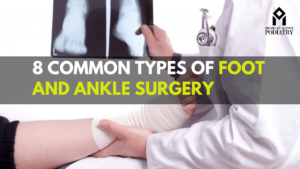Foot surgery, while often necessary for alleviating pain and restoring function, carries inherent risks, including the potential for nerve damage. Nerve injuries can lead to symptoms such as numbness, tingling, or loss of sensation, impacting both physical and emotional well-being. In this comprehensive guide, we delve into the complexities of nerve damage from foot surgery, empowering individuals with knowledge to navigate their recovery journey effectively.
Understanding Nerve Damage in Foot Surgery: Unraveling the Complexity
Nerve damage in foot surgery can occur due to various factors, including surgical manipulation, compression, or inadvertent injury. Nerves in the foot and ankle region are delicate structures responsible for transmitting sensory and motor signals, and their integrity is crucial for normal function. Let’s explore the nuances of nerve damage and its implications in the context of foot surgery.
Types of Nerve Damage: An Overview
Nerve damage in foot surgery can manifest in different forms, each presenting unique symptoms and challenges:
- Peripheral Nerve Injury:
- Peripheral nerves located in the foot and ankle region may sustain damage during surgical procedures, leading to sensory disturbances or motor dysfunction.
- Compression Neuropathy:
- Prolonged compression or pressure on nerves during surgery or post-operative immobilization can result in neuropathic symptoms such as numbness, tingling, or weakness.
- Traction Injury:
- Traction or stretching of nerves during surgical manipulation can cause injury, disrupting nerve conduction and leading to sensory or motor deficits.
Risk Factors for Nerve Damage: Identifying Vulnerabilities
Several factors may increase the risk of nerve damage during foot surgery, including:
- Surgical Complexity: Procedures involving intricate anatomical structures or extensive dissection may pose a higher risk of nerve injury.
- Patient Anatomy: Variations in nerve course or proximity to surgical sites can influence susceptibility to injury.
- Surgeon Experience: Surgeon skill, technique, and familiarity with nerve anatomy play a crucial role in minimizing the risk of nerve damage.
- Pre-existing Conditions: Underlying neuropathies, diabetes, or vascular disease may predispose individuals to nerve injury and affect nerve regeneration.
Symptoms of Nerve Damage: Recognizing the Signs
Identifying signs of nerve damage following foot surgery is essential for prompt intervention and management. Common symptoms may include:
- Numbness or Tingling: Sensory disturbances such as numbness, tingling, or “pins and needles” sensations in the affected area.
- Weakness or Muscle Atrophy: Motor deficits, weakness, or muscle wasting may occur if motor nerves are compromised.
- Altered Sensation: Changes in sensation, such as hypersensitivity, burning pain, or loss of sensation in specific areas of the foot or ankle.
- Difficulty with Movement: Impaired coordination, balance, or difficulty performing fine motor tasks may indicate nerve dysfunction.
Management of Nerve Damage: A Multifaceted Approach
Addressing nerve damage from foot surgery requires a comprehensive approach tailored to individual needs:
- Early Intervention:
- Prompt recognition and management of nerve injuries, including close monitoring, symptomatic treatment, and rehabilitation, can optimize outcomes.
- Neuromodulatory Therapies:
- Modalities such as transcutaneous electrical nerve stimulation (TENS), acupuncture, or medications targeting neuropathic pain may provide relief from symptoms.
- Physical Therapy:
- Rehabilitation exercises focused on nerve gliding, strengthening, and proprioceptive training can promote nerve regeneration and functional recovery.
- Surgical Revision:
- In cases of severe nerve injury or compression, surgical exploration and revision may be necessary to decompress the nerve or repair the injury.
- Patient Education and Support:
- Educating patients about nerve damage, its implications, and strategies for self-management empowers individuals to actively participate in their recovery journey.
The Role of a Podiatrist: Partnering in Nerve Health
Throughout the evaluation, treatment, and recovery process, a podiatrist serves as a trusted ally, offering expertise, support, and personalized care:
- Preoperative Assessment: A podiatrist conducts a thorough evaluation, assessing nerve function and identifying potential risk factors for nerve damage.
- Intraoperative Vigilance: Skilled in nerve anatomy and surgical techniques, a podiatrist employs meticulous care to minimize the risk of nerve injury during surgery.
- Postoperative Management: From monitoring recovery progress to implementing targeted interventions, a podiatrist provides comprehensive support to optimize nerve healing and functional outcomes.
Conclusion: Empowering Recovery Through Knowledge and Collaboration
In conclusion, while nerve damage is a potential complication of foot surgery, proactive measures, early intervention, and collaborative care with a podiatrist can facilitate optimal recovery. By understanding the risk factors, symptoms, and management strategies associated with nerve damage, individuals can navigate their post-operative journey with confidence and resilience.




